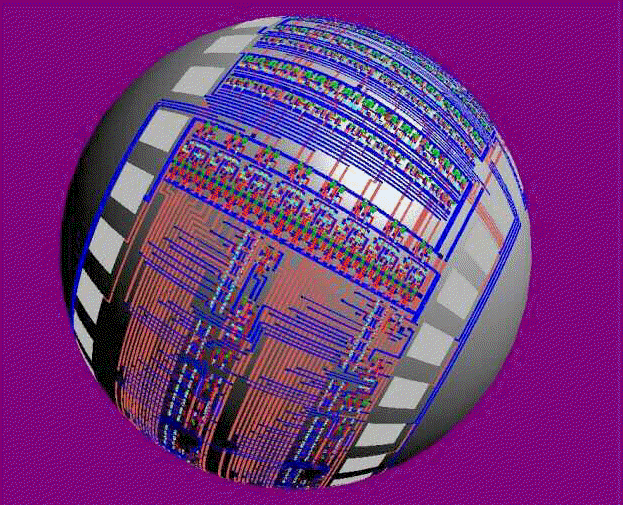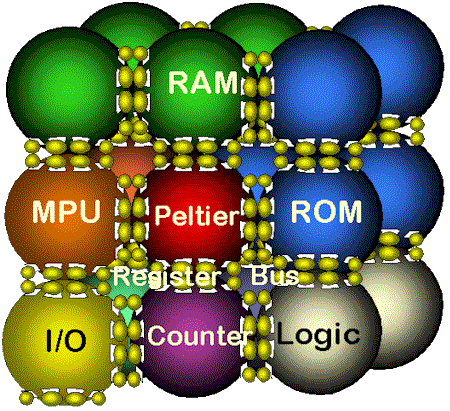

![]()

The process of creating silicon processors begins with sorting poly-crystal granules by weight and/or size to get the correct amount of material to form the 1 mm spheres. The granules are melted and dropped down a long tube while cooling and dopants are added to create the spheres that are then polished. The circuitry is done using the same masking, etching, and cleaning processes conventional chips go through. However, the spheres float through 2 mm hermetically sealed pipes and tubes during the entire process except for photolithography in which the circuit pattern is transferred. As a result, large clean rooms are unnecessary.

To transfer a 2D circuit design onto a 3D sphere, BALL Semiconductor Inc. (BSI) developed a tool called ABLE (Advanced Ball Layout Editor). The circuit is designed using a 2D CAD tool, and the rectangular coordinates are transformed into spherical coordinates that wrap the design around the middle of the sphere. Ray tracing is employed to convert this pattern into a mask that a system of 45 mirrors transfers onto 60% of the surface in one flash of light.
To utilize more of the surface area of the sphere, BSI has recently developed the "Maskless Lithography System" that uses ABLE and the "digital mask". This process directly creates images that are transferred onto 98% of the surface in one flash using six mirror devices and almost half a million mirrors.

One advantage of spherical processors is a decrease in cost. BALL Semiconductor Inc. (BSI) hopes to decrease the cost of creating processors by up to 90%. They are creating a process in which the balls travel through hermetically sealed quartz tubes rather than clean rooms to lower the cost of production facilities. The plants are estimated to cost about $100 million rather than the $1.5 billion cost of conventional chip plants. Also, the use of spheres eliminates some of the steps needed to make chips, such as the final assembly stages. In addition, there is less wasted material, energy, water, and other resources since 90-95% of the original silicon material can be shipped as a final product compared to the 10-20% for chip technology.
Another important advantage of spherical processors is a decrease in production time. Spherical processor creation takes 5 days compared to 120-180 days for chips. This helps eliminate some cash flow problems. Little money is tied up in work-in-process costs. Also, fewer assets are tied up in finished goods that go to waste since planning can be based more upon actual orders rather than demand forecast. This eliminates some of the need for inventories and storage facilities, which also aids in decreasing cost.

A third important advantage of spherical processors is their size and flexibility. A 1 mm diameter sphere contains 3.14 mm2 of usable surface area compared to the 1 mm2 usable surface area of a 1 mm length chip. This allows for more circuits to be created than on a processor of comparable size. Also, the spherical processor will decrease in size rather than increase in size as chips do to incorporate new functions. Plans are to decrease size to 0.8 mm, then possibly 0.5 mm, 0.1 mm and even smaller. And, instead of adding more functions on a single component making the processor more complex, the functions will be contained on separate spheres that have been clustered together. In this manner, much of the existing equipment can continue to be used with a few modifications as the spherical processors evolve rather than overhauling the entire plant as will need to be done to increase the size of chips. Since current equipment would not need to be replaced, innovation is easier because smaller investments are necessary. This allows for a more stable environment because large investments of money are not needed every few years.


One disadvantage of spherical processors is that an approach to utilize the entire surface area of the sphere is still needed. BALL Semiconductor Inc. (BSI) is currently able to utilize 98% of the sphere's surface. They are developing a Lozenge Cell, Grid concept and multi-axis algorithm to address the issues of looking at the entire design surface as a whole and defining a unit shape that can be repeated over the sphere and provide 100% coverage without gaps.
Another disadvantage of spherical processors is the issue of refining the alignment of the spheres during the processing and transportation stages in the sealed tubes as the resolution is decreased. This has not been an issue in production thus far because of the use of contacts, but as more gates are required, a finer geometry and use of holographic lithography may be required.

Inductance methods are being developed in which interconnect lines are wrapped around the silicon spheres to the I/O area to incorporate radio frequency transmission functions. In this manner, the sphere can act as an antenna and transmit radio frequencies, allowing for wireless communication up to 10 meters. Due to their size, these transmitters could be used in such products as smart cards, tag for cargo and baggage, and toys that require motion sensors like remote controlled cars.

One of the main areas in which these silicon spheres could be used is the medical community. The spheres could sense movement and direction and measure temperature and acceleration. Such a device could be used in wheelchairs or in pacemakers to detect body acceleration and perform the necessary compensation on the heart rate. Also, such devices could be put into tablets that are ingested to monitor body temperature or functions in a specific area of the body, though methods to maintain the device's position and retrieve the device after use must still be developed. In addition, these devices are small enough to be attached to surgical equipment so the patient can be scanned to be sure no equipment has been left inside the patient.
Another main area in which these silicon spheres could be used is the automobile industry. An accelerometer is used to detect changes in acceleration for air bag deployment. Using the spheres could allow acceleration measurement in three dimensions so the air bag could be used when hit from the front, back, sides, or top rather than just the front. Also, the spheres could be used to measure engine temperature and pressure.

Spherical chips could increase without the need to increase size and complexity. Moore's law stated that "chips double in capacity every 18 months," and because there are limits on the number of circuits that can be placed in a wafer area without electrical interference between the circuits, processors will be more complex without the spherical approach. Complex designs need more time to complete and need to have higher performance to compete after its long production cycle.
The manufacturing cost of spherical processors is cheaper than normal processors. This will appeal to many people to buy it. Also the learning curve states that manufacturing cost decreases over time, and increasing in volume will decrease the time needed to get down the learning curve that will help to increase purchasing and manufacturing efficiency.
The most common metrics to choose a design are cost and performance of this design. The cost of producing and manufacturing a spherical chip is equal to 1 tenth the cost of a normal chip with comparable functions. The performance of spherical is easier and need less time to improve because it has a simple design and it needs shorter production time.

